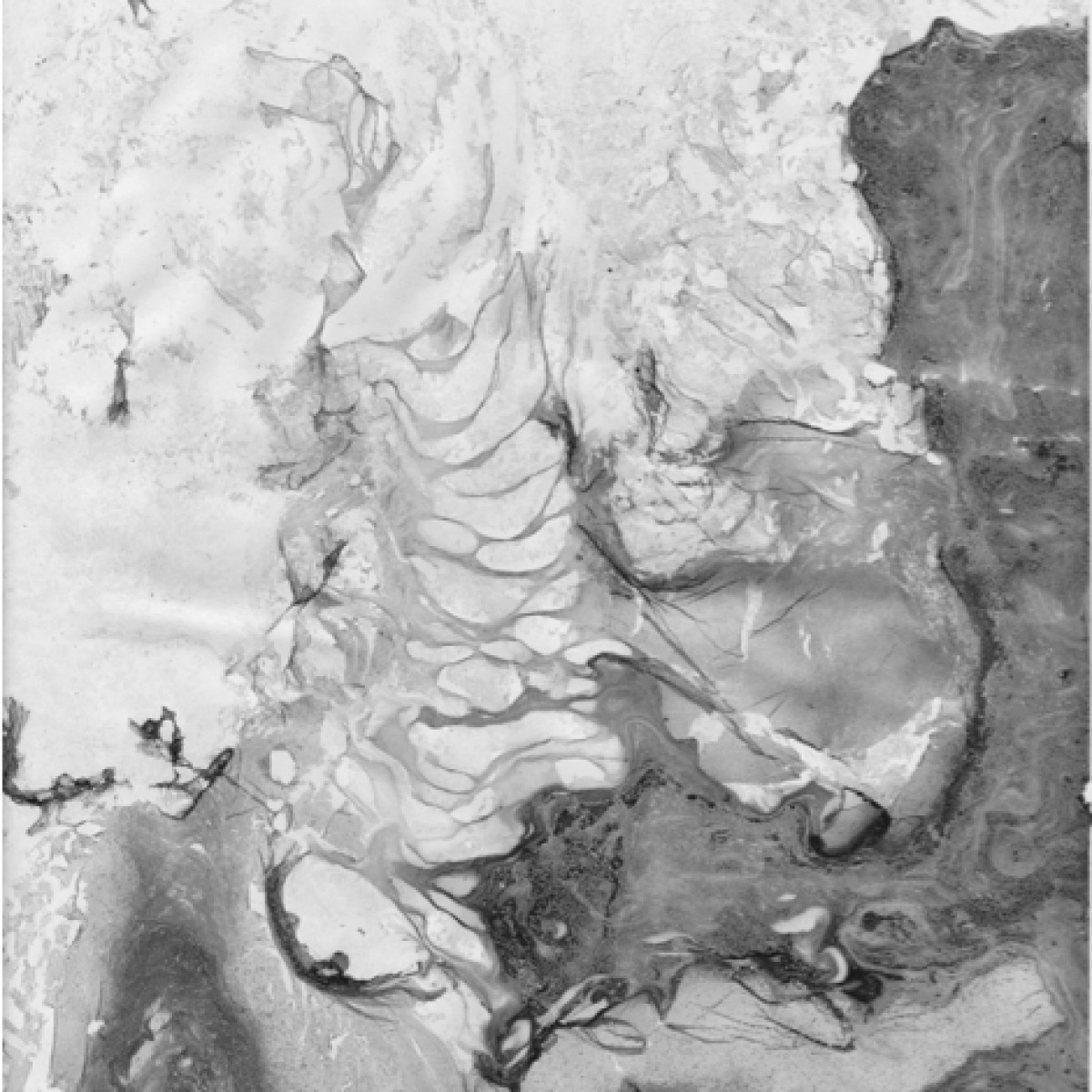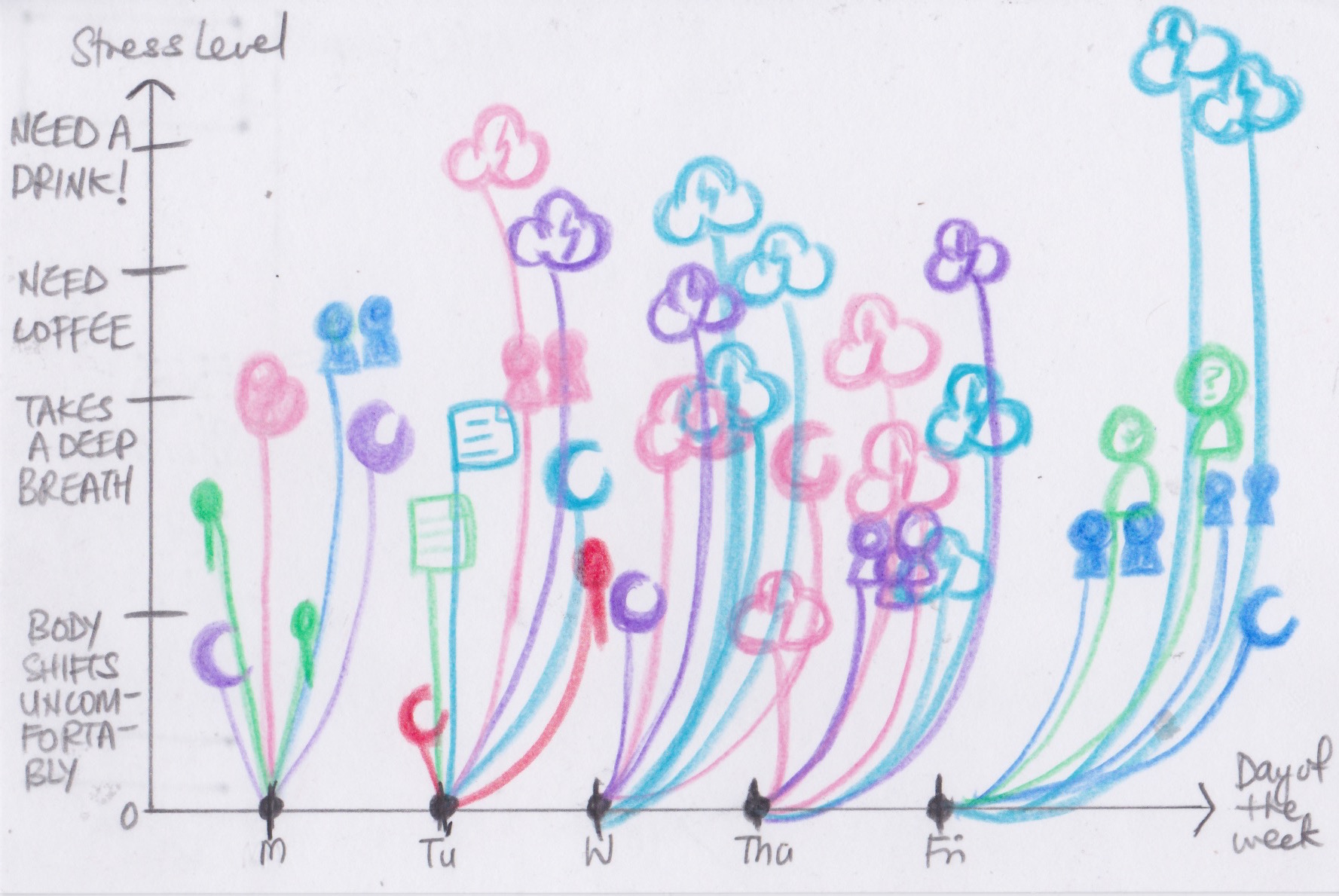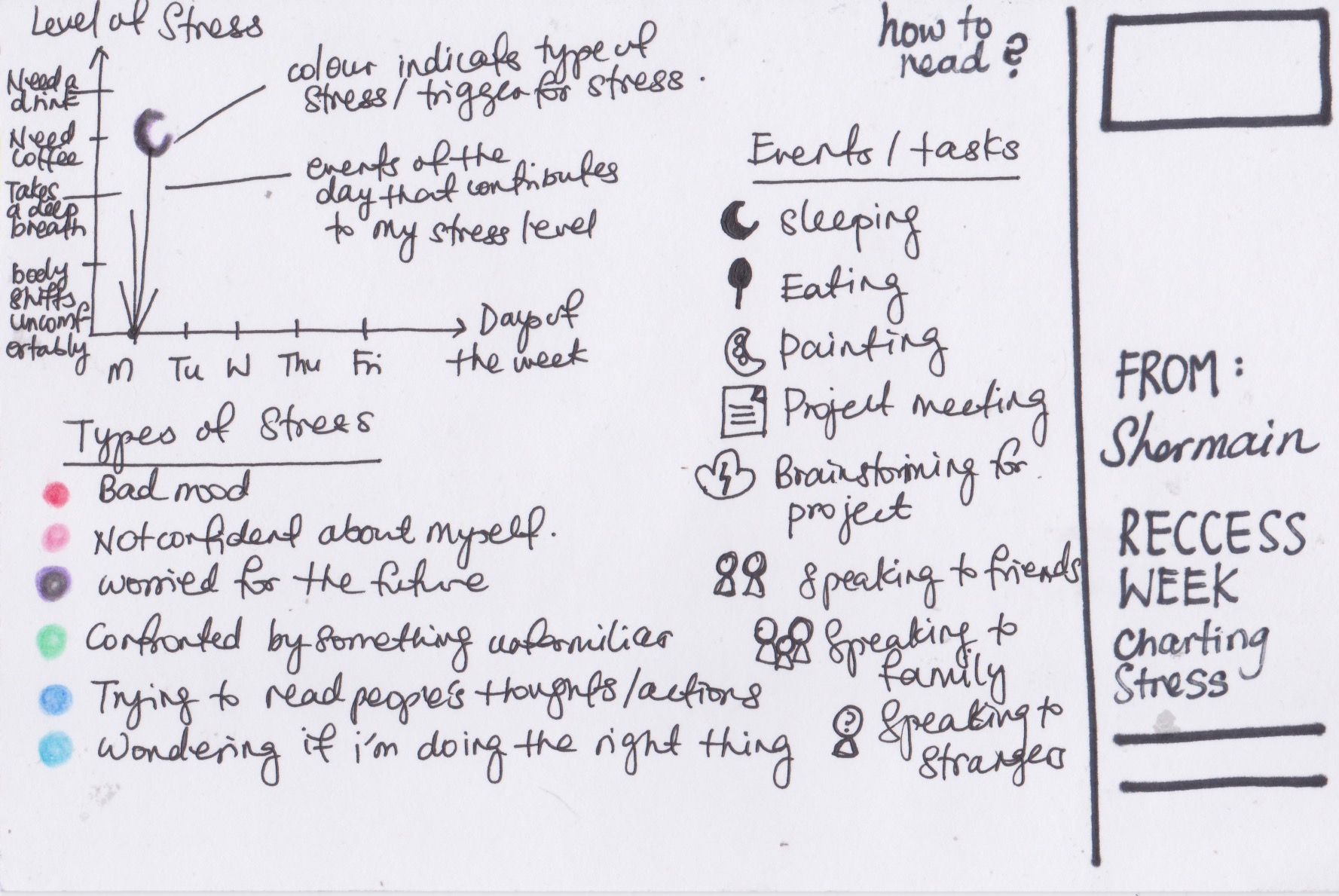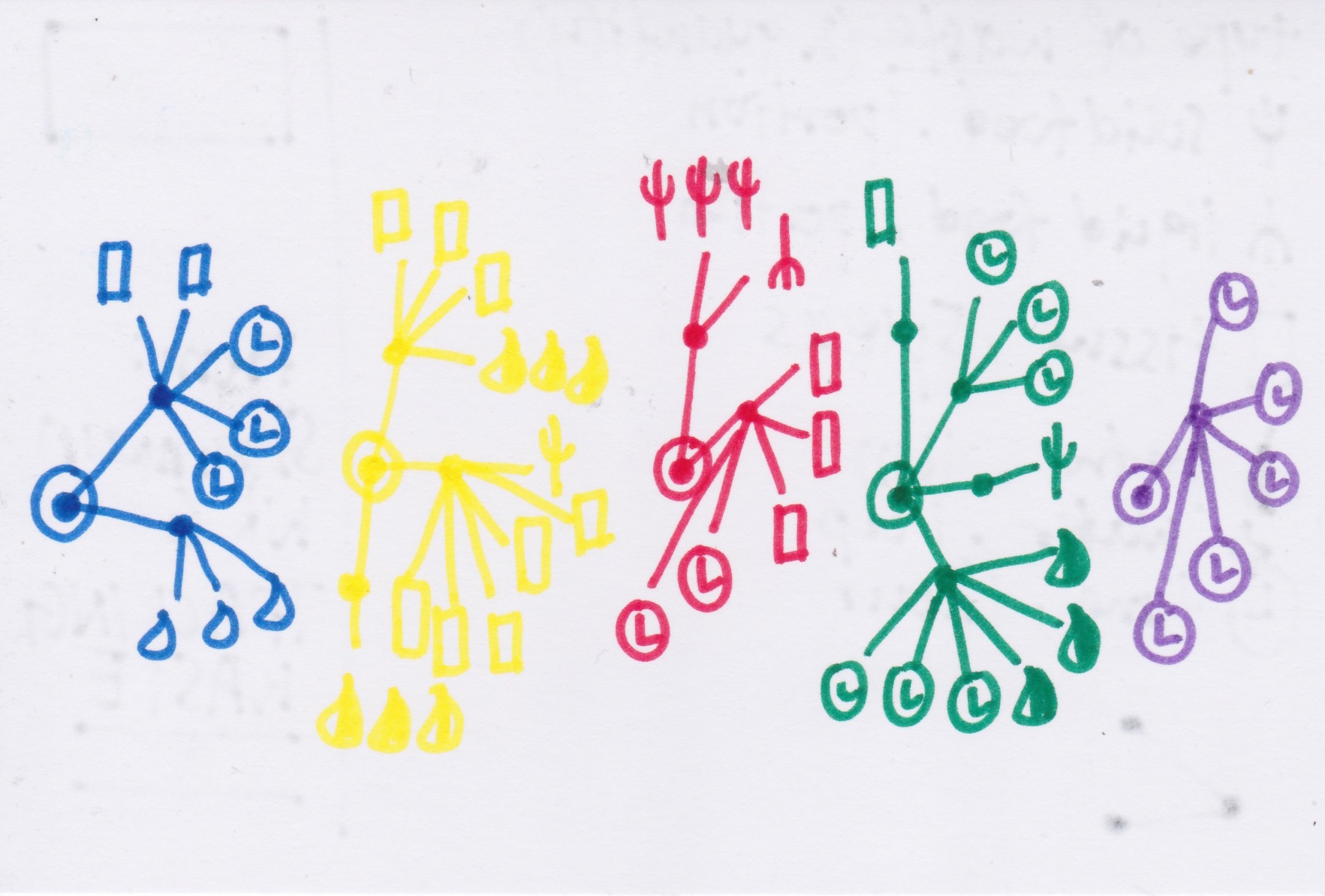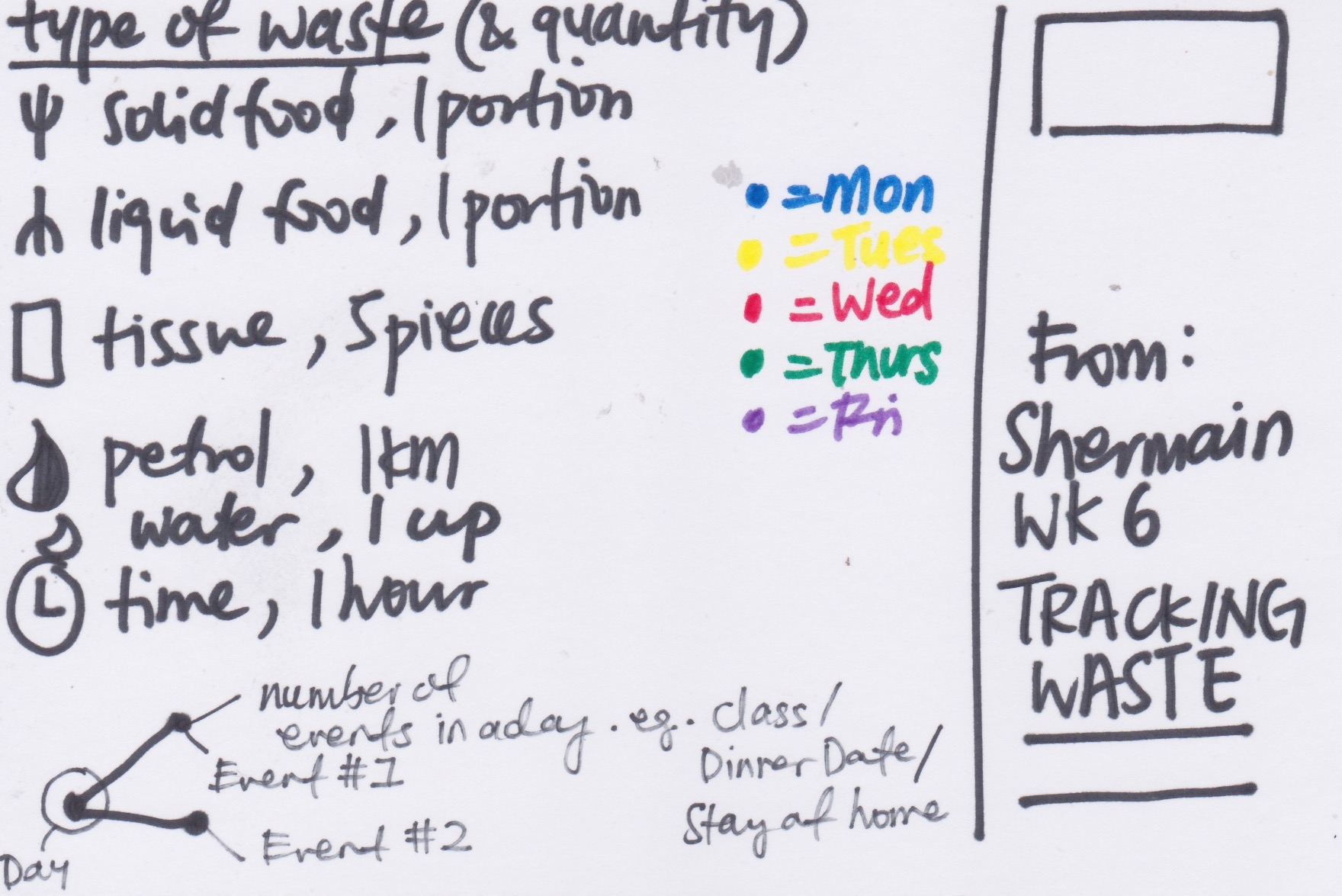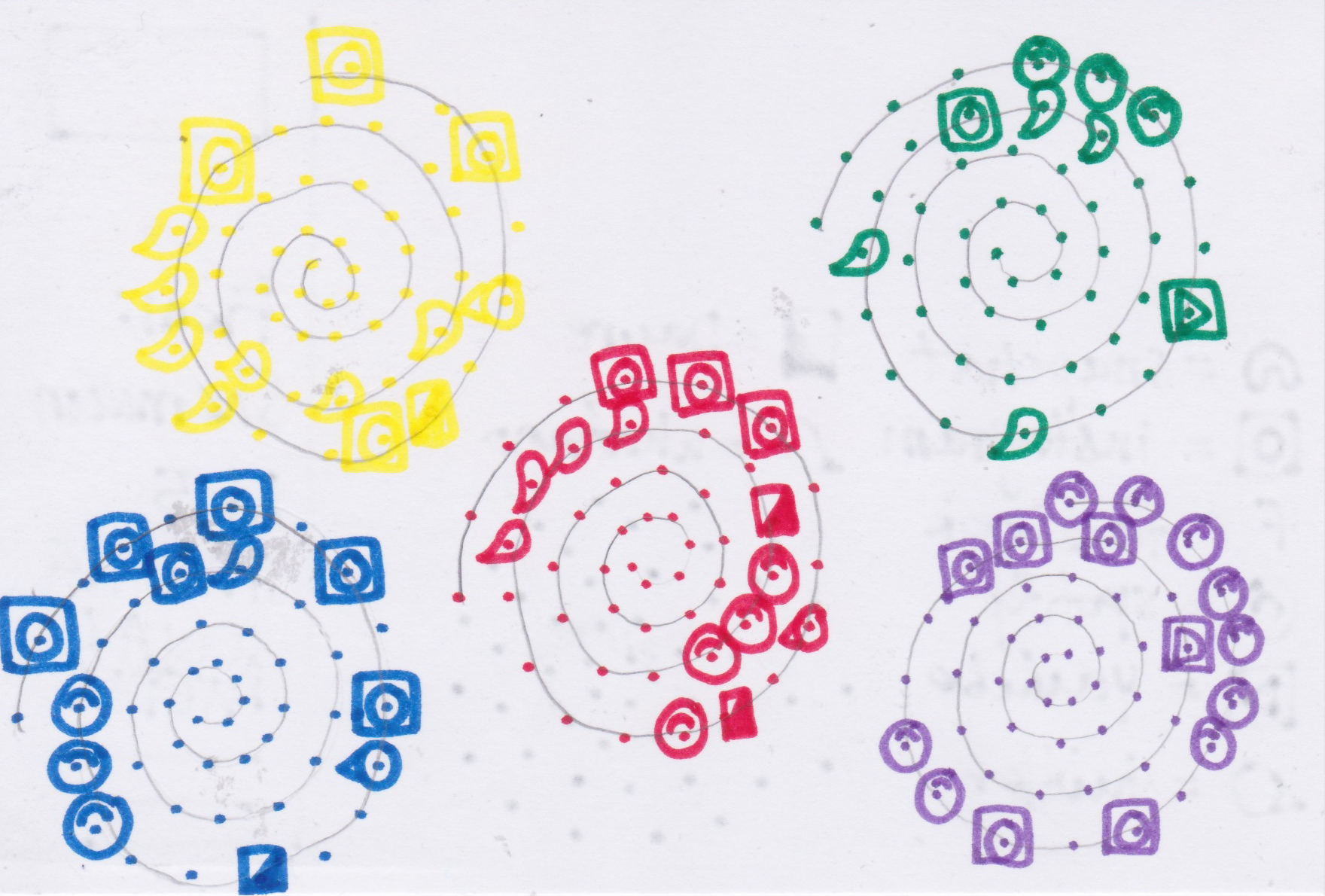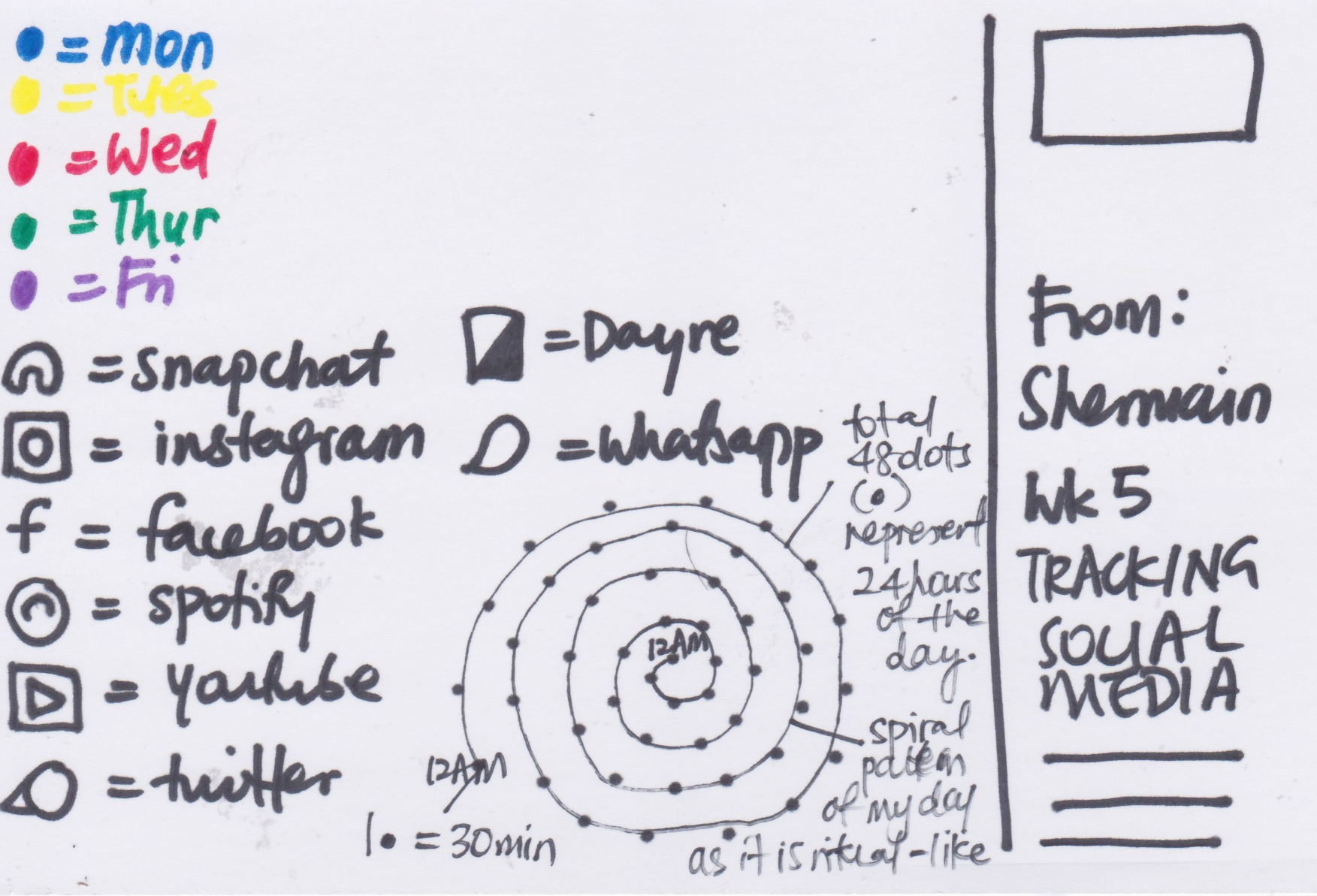Tracking stress levels! I enjoyed figuring out what are the kinds and qualities of stresses that were affecting me for this practice. It helps me put my day into perspective and shows me a pattern of stress that i experience daily based on time (i.e. morning, afternoon and night time)
Week 6: Tracking Waste Usage

This was an interesting data collection for me because I was curious to see exactly how much waste I consume. Honestly, I’m the worst nightmare of tree lovers because the amount of tissue I consume within a day is insane. I blame it on my sinus and weak, feeble body. While people carry around small packets of tissue, I literally carry around tissue boxes. Any rainy weather or dusty environment triggers my nose to go all out into a phlegm party. In fact, you can see this from my data on Tuesday. That night was so cold and rainy, I believe I managed to use half a box of tissue. Surprisingly, this data was also revealing of my lifestyle. Personally, I don’t really consume or indulge in many things. In a way, I find it tiring to a certain sense to engage in any activity or use anything hence my first reaction to MANY things that approach me is to just simply reject it first. This is a really bad habit that limits my experience in a sense and I should be working on this. I included petrol usage intentionally as well because I’m somehow aware of how much I’ve been uber-ing these past few months and I thought it’ll be good to record it down to show it to myself.
Week 5: Tracking Social Media Usage

I’m a person who is constantly on social media, checking for updates or something to entertain me. I don’t like spending my time doing absolutely nothing because I feel that, that time can be used to my advantage, for instance educating myself by reading articles or improving my sense of taste by scrolling through aesthetically pleasing photos on instagram. Yet years of being so constantly engaged with the world wide web has indeed taken some negative effects on me, I began to realise scrolling through large amounts of information was not helping me improve, or be a better person. To put it simply, instantaneous information just wasn’t cutting it. The ‘instant’ world was not helping me. Instead, I’ve learnt to give myself ample time to be in my own ‘headspace’ and learn to formulate thoughts within me, only seeking the world wide web for inspiration when I have the ability and energy to absorb what it’s willing to offer.
I’ve come to realise that my interaction with the social media world is rather ‘ritualistic’, i stick to a certain schedule and i check social media rather periodically (i.e. almost every 30 mins) given that I’m quite concerned about time even in my daily life. Hence, I decided to represent the time of the day into intervals of 30mins, with each dot representing a half an hour. Hence, each day contains 48 dots in an outward spiral manner. Then, within each dot, i record the most prominent social media activity that i have used in that half an hour. I actually see a pattern from my data: The type and duration of social media that i use usually depends on time of the day, my mood and event of the day. For instance, I usually start the day by watching a youtube video or replying my whatsapp messages. In the evening when i have classes, I tend to be chatting with my friends on whatsapp. Later in the night while commuting home, I like to either listen to music or read dayre to learn about other people’s day, an online platform that acts like an instant diary/blog. At night, when i feel bored, I like to go on instastory to check out what people are doing at night. Also, if i tend to be meeting my friends, I’m either off social media or I would be on Spotify, listening and sharing music with the friend I’m with as a way of bonding.
Week 4: Visualising Contact with Liquids

Honestly, I was really excited to visualise my contact with liquids because I’ve been sick for the entire week. Which means that I’ve been taking in and giving out loads of unattractive, gross amounts of liquids.
This visualisation did not turn out as clear as i would have liked to. But here’s how to read it: The three lengths of times represents the three different times of the day. Namely, the longest being morning, middle being afternoon and shortest being night. Because these were how my days felt when i was ill. The horizontal lines in different colours represents the type of liquids and its length represents the amount of liquid I was in contact with. Also, the direction of the horizontal line tells if the liquid was given out(left) and taken in(right). The closeness of each horizontal line also tells of how often I come in contact with the liquid.
An interesting pattern that I noticed was that, after consuming large amounts of water, the amount of mucus i was giving out was much, much lesser which proves that water is indeed really necessary for a sick soul! But in comparison, when I consumed 2 pints of beer on day 2, I definitely felt for its effects and paid for it because on day 3, I was blowing out humongous amounts of mucus.
I never knew info visualisation could be so funny and musing heh.
Week 3: Visualising Sound

Visualising sound was particularly a challenge because there were already many indicators and measurements that were available in the field of sound and music. Out of sheer fun, here is the list of possible measurements i put together:
- Amplitude/loudness
- Pitch
- Tempo
- Mood
- How does it make you feel
- Syllabus/lyrics/ pronunciation
- Vibrations
- Layering of voices
- Repetitions/ ups and downs
- Pitch
- Instruments
- Loudness
- Positive/negative ; major/minor
- Moments of…
- Pauses
- Accents; !
- Colours-sounds (synesthesia)
- Ability to understand/Rolling of tongue/Clarity
- Number of participants
- Smoothness of melody; abrupt pauses
- The letters involved
In the end, I let my body decide which part of the song appealed to me the most and focused on 1:05 – 1:43 + aaah! What stood out to me was the three ‘voices’ and the kinds of ‘dynamics’ that they brought to my ears. I chose the three final elements to be tempo, pitch and the type of instruments. The information can be read like a book, from left to right and up to down.
What surprised me in the end was how the visualisation turned out to be more complex in the end. Despite only choosing three elements to consider, the visual outcome turned out more emotive, animated and fun than i expected 🙂
Week 2: Visualising Taste

ABOVE: FERN FRONDS
When creating this postcard, I wanted all my information to be centred around the element of time. Hence, I created used the hour and minute hands that is conventionally found in clocks and simplified them into two lines pivoted on a point. They tell the time in the interval of 5 seconds.
In my impression, intensity meant greater higher waves and greater lengths. Hence, i decided to visualise them as waves. In addition, the number/frequency of waves could help me show the number of bites I had to take. The visualisation of wave helped to show the dual nature of intensity and frequency.
Lastly, the 4 flavours that we taste is represented by 4 different colours. These colours are based on the foods that reminds me of a certain taste. For instance, yellow for sour because of lemons.
I decided to use the same elements for both postcards because I’m interested to see how both taste tests played out for me in comparison!
Codexes, boundaries, making meaning
So i’ve been looking into codex as a possible final form of my fyp. In a way, developing from the idea of the codex as a dictionary, a way of classification of things and the way in which we should classify things led me to think about boundaries, or how do we dissect/ make sense of the world or specifically space.
I was reading up on ‘Islands of meaning’ by Eviatar Zerubavel (1991) and found several ideas worth mentioning.
Things assume a distinctive identity only through being differentiated from other things, and their meaning is always a function of the particular mental compartment in which we place them. Examining how we draw lines will therefore reveal how we give meaning to our environment as well as to ourselves.
Making sense of the physical space around us through our mental understanding.
We transform the natural world into a social one by carving out of it mental chunks we then treat as if they were discrete, totally detached from their surroundings. The way we mark off islands of property is but one example of the general process by which we create meaningful social entities.
Examining spaces.
The perception of supposedly insular chunks of space is probably the most fundamental manifestation of how we divide reality into islands of meaning. Examining how we partition space, therefore, is an ideal way to start exploring how we partition our social world.
SONICreflection, 2016

SONICreflection, 2016
Wok lids, tweeters, pencil microphones, computer with software, amplifiers, sound card and aluminium
380 × 673 × 134 cm
Collection of the Artist Zulkifle Mahmod
Singapore Biennale 2016 commission
Singapore in the twenty-first century is a mélange of sights, smells and sounds of various Southeast Asian communities that have taken root here in recent years. The Thai community, for instance, congregates in Golden Mile Complex, while the Burmese diaspora is known to be concentrated in Peninsula Plaza; each ‘sonic territory’, as Zulkifle dubs them, boasts a unique soundscape all its own. SONICreflection is a sound sculpture: recordings from a number of these sonic territories are transmitted from multiple tweeters mounted on a wall lined with wok lids; pencil microphones are used to amplify the resultant cacophony, which assumes the form of layers of everyday, ambient clamour, ranging from snippets of dialogue to incidental noise. In exploring the micro-universes of Singapore’s cultural hodgepodge, Zulkifle’s work foregrounds the otherwise overlooked auditory character of each community and the space it inhabits.
all information taken from SAM website for SG Biennale.
http://www.channelnewsasia.com/news/lifestyle/5-works-to-check-out-at-the-singapore-biennale-2016/3240010.html
https://www.singaporebiennale.org/zulkifle-mahmod.php
Thoughts: I finally found a local artwork that resonates with what i am thinking! This artist has amazing sound works that is localised in the context of Singapore. A great plus that he mentions Golden Mile as well.
This time, the SG biennale has artworks addressing topics of the environment or question about borders, putting the spotlight on present-day conflicts and conundrums. This will probably provide good information for research.
Architecture and the Architect: Image-making in Singapore
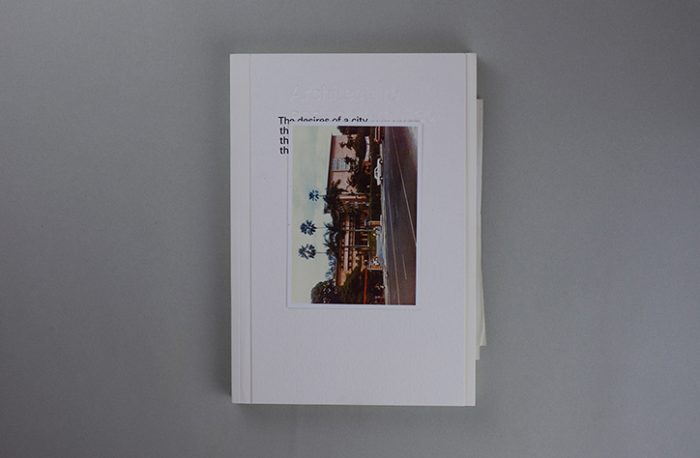




A publication produced by Do Not Design Singapore which acts as a catalogue, sort of a ‘dictionary/vocabulary’ of sorts about the architecture in Singapore. The sections are classified according to their functions/purpose and each title of the section are poetically phrased. Images of the buildings are inserted with interviews by various ‘participants/inhabitants’ for instance the architects who built the buildings such as Tay Kheng Soon (who built the People’s Park Complex) , local photographers and others.
I like how the contents of the interviews are not restrictive. The author discusses open topics such as the architect’s sentiments towards architecture in Singapore today instead of simply asking them about the old buildings that they built. I like the contrast of someone who built a building for past Singapore commenting on the present day now and how relevant or irrelevant his building is in the present day.I also like the personal sentiments that we get to hear from an architect who is building something for the national landscape. The contents of this book are seemingly very vast and varied. But that’s what i like most about it. Even though the topics are very varied, it gathers to form a loud collective voice that speaks of how Singapore are seen through the architects and the inhabitants as suggested by the title of the book. I aim to reach this sort of ‘collective’ aesthetic.
Biblio
ARCHITECTURE AND THE ARCHITECT:IMAGE-MAKING IN SINGAPORE
By Virginia Who and Bell Tan with photographs by Beton Brut and six contributing photographers
http://www.itsnicethat.com/articles/do-not-design-studio-220116
http://www.buro247.sg/culture/buro-loves/a-new-book-chronicles-singapore-s-best-buildings-f.html
http://www.straitstimes.com/lifestyle/landmarks-of-the-singapore-dream
Exploring the power and relationship of the senses

Event #1, 11/9/2016: Design Film Festival ( In Pursuit of Silence)
“Silence is where we speak something deeper than our words…”
“Silence returns us to what is real.”
“If nobody’s talking, nobody’s dominating,”
I caught several films at the Design Film Festival this September 2016. One which i was looking forward to the most was In Pursuit of Silence. It is a documentary film that speaks about the beauty of silence, its spiritual and physical benefits and the effects we are experiencing individuals and collectively in our increasingly noisy world. Yet, there is an additional layer of poetics that is peeking through the meanings of the film. The trailer was strikingly thought-provoking. It was a compilation of people from different fields of specialities speaking about the ‘Silence’ itself. The visuals that were linked to silence surprised me. They ranged from big cities to vast forest landscapes. I wonder though, how would it be like to talk about the politics of silence or noise?
SYNOPSIS
In the noise of the modern world, silence is fast becoming absent. As much a work of devotion as it is a documentary, Patrick Shen’s film powerfully begins with an ode to John Cage’s seminal silent composition 4’33” then passes as a piece of meditative cinema that explores the human relationship with silence and sound, and the impact of noise on our lives.
4’33” , John Cage
4’33” pronounced “Four minutes, thirty-three seconds” or just “Four thirty-three“) is a three-movement composition by American experimental composer John Cage (1912–1992). It was composed in 1952, for any instrument or combination of instruments, and the score instructs the performer(s) not to play their instrument(s) during the entire duration of the piece throughout the three movements. The piece purports to consist of the sounds of the environment that the listeners hear while it is performed. The piece refers to the total length in minutes and seconds of a given performance, 4′33″ being the total length of the first public performance.
4′33″ originated while the composer was working on Sonatas and Interludes around 1947–48. For Cage, it became the epitome of his idea that any sounds may constitute music. It was also an attestation to the influence of Zen Buddhism, which Cage studied since the late 1940s. In a 1982 interview, and on numerous other occasions, Cage stated that 4′33″ was, in his opinion, his most important work. The New Grove Dictionary of Music and Musicians describes 4′33″ as Cage’s “most famous and controversial creation”.
An excerpt from an article speaks of 4′33″ in the film,
Archival footage reveals the avant-garde composer John Cage ruminating on how his almost mystical relationship with silence informed his compositions, including the legendary 4’33” — a work that consists of four minutes and thirty three seconds of silence (or, rather, of whatever ambient sound exists wherever this work is being performed) . Indeed, the movie begins with an homage to Cage — the first four minutes and thirty-three seconds of the film are silent, a de facto performance of Cage’s 4’33” set to a succession of lovely images. Cage (and 4’33”) dance throughout the film, with looking at how controversial the composition was when it was first performed in the 1950s, and how respected it is today — perhaps because we’re slowly coming to realize just how valuable (and endangered) silence is?
Traditionally, silence is an absence of sound. In my exploration towards how the senses and the big cities relate, I thought that the film brought up several good points worth thinking about especially towards the meaning of ‘Silence’ in today’s times.
- It is possible to teach an audience to appreciate a sensory experience through an art piece. John Cage’s 4’33” was initially not well-received by the public. It was perceived to be a joke of some sorts, for the audience were expecting an orchestra to be playing a music piece having paid for a concert. Recording footage showed audience chuckling, fidgeting uncomfortably and even sighing in frustration amongst the silence. However, they were later noticed to be embracing and appreciating the silence. The art piece ended with a standing ovation and was very well-received.
- To what extent should a sensory experience be measured? A soundscape technician speaks in technical terms of how certain decibels indicate certain geographies of the earth such as the sounds of crackling ice in the snow of the poles on a fine day versus a windy day. It reveals a relationship between the measuring of a sound and the meaning of the sound itself.
- Engaging in our senses allows us to keep in touch with our innate, most truest selves. A Japanese researcher discusses about the potential of silence within the forests that enhances human health simply because it reduces stress.
To quote,
Silence is not just a kind of spiritual treat, but actually an essential condition for human wellness — which makes the pervasive noise of our technological world all the more troubling.
- Senses can be a medium to express a concept. For instance, the relationship between silence and the body.The Japanese have a cultural tradition of the tea-making ceremony. During this procedure, all participants are to shed themselves of their physical possessions and partake in this meditation in silence. Silence plays an important role here. It removes people of their rank, their history and everything else that comes along with their identities. In the teahouse, everyone are equal. Because they do not speak through sound and only through their bodies, the silence mediates their positions and they only express through the common notion of tea-making.
To quote,
Monastic silence yields to the silence of nature and the wilderness, in a wordless recognition that silence originates from and takes us to a place beyond dogma or socially constructed meaning. Rather than promoting any kind of ideology, the film ponders insights such as Prochnik’s musing on how silence is “the interruption of the imposition of our own egos upon the world.”
- With silence, exists noise. How does these two opposites relate?
Additional information can be found in : http://www.huffingtonpost.com/carl-mccolman/in-pursuit-of-silence-a-q_1_b_9396596.html, http://solomonsmusic.net/4min33se.htm
